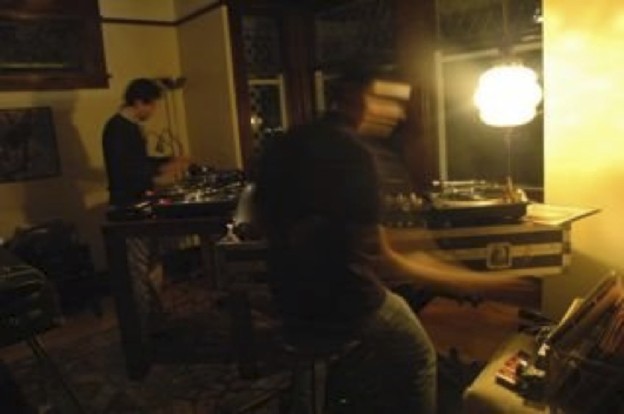'Schizophonophilia'
Wayde Compton and Jason de Couto, The Contact Zone Crew

In their poetic experiments with electroacoustic technologies, Wayde Compton and Jason de Couto — known as The Contact Zone Crew — advance what Compton has called schizophonophilia: “the love of audio interplay, the pleasure of critical disruptions to natural audition, the counter-hegemonic affirmation that can be achieved through acoustic intervention.”[1] As an audio poetry project, Compton and de Couto realize schizophonophilia by using sampling and mixing as the core of their poetics. They work with sounds from instrumental hip hop, jazz, black spirituals, Japanese music, sound effects, and custom made dub plates (containing recorded readings by Compton), mixing them to create complex audio poems that sound like this:
For Compton, the concept of schizophonophilia departs from the thinking of Canadian composer R. Murray Schafer’s similar term “schizophonia.” In his The Soundscape: Our Sonic Environment and the Tuning of the World, “schizophonia” describes “the split between an original sound and its electroacoustic reproduction” and is characterized as an “aberrational effect of the twentieth century.”[2] The condition of schizophonia, for Schafer, arises in part from the increasing availability of audio recording technologies, which make it more possible for sound to travel away from its time and place of origin.
For many poets of the twentieth century avant-garde, the concept of “schizophonia” is an important benchmark for defining one’s sound poetry practice, especially for determining how the voice is mediated as part of any given work. The term seemingly guides Steve McCaffery’s 1978 survey of sound poetry, wherein the prevalence of audio technology contributes to how he categorizes particular nodes of activity. In the 1950s, which McCaffery refers to as the beginning of the “Current Decades” for his survey, audio technologies reconfigure the voice as a “point of departure rather than the point of arrival” (10) thus sound supersedes “body time” and renders time and space as “less controlling and more manipulable factors of audiophony.”[3] (11). Though this is not always true, sound poets of the twentieth century in North America tended to fall into one of two categories: those who employ electroacoustic technologies to modify their voice and those who do not. In Canada, many of the poets within McCaffery’s social-poetic locus — like the Four Horsemen (Steve McCaffery, Rafael Barreto-Rivera, Paul Dutton, and bpNichol), Owen Sound (Michael Dean, David Penhale, Steven Ross Smith, and Richard Truhlar), and First Draft (Susan McMaster, Andrew McClure and Colin Morton) — tended to veer away from the use of electroacoustic technologies as a core component of their work.
In distinction, schizophonophilia welcomes the disruption of the voice and the dislocation of sound. It challenges the limits of the body as the origin point of vocalization in poetry and asks “whose voices can participate in the act of poetic meaning-making?” As a duo, Compton and Decouto use up to six turntables plus a digital turntable and a sampler in any one performance, which offers the opportunity to sound out a diverse range of voices at any one given time. Part of the impetus for the group is in the name — “contact,” the layering of voices, sounds, and textures on top of one another to create a new auditory experience. And while the bodily imminence of Canadian sound poetry in the 1970s and 1980s offers a point for face-to-face connection, The Contact Zone Crew’s offerings are perhaps more far reaching, especially since a core component of their practice relies on the invitation and integration of other voices into the mesh of their sonic creations. Their sampling, mixing, and modulations offer new possibilities for vocalization in poetry and create an expansive zone for the meeting of rhythms, sounds, voices, and identities.
1. Wayde Compton, “Turntable Poetry, Mixed Race, and Schizophonophilia,” After Canaan (Vancouver, BC: Arsenal Pulp Press, 2010), 199.
2. R. Murray Schafer, The Soundscape: Our Sonic Environment and the Tuning of the World, The Soundscape: Our Sonic Environment and the Tuning of the World (Rochester, VT: Destiny Books, 1993), 293. [First printed 1977.]
3. Steve McCaffery, “Sound Poetry: A Survey,” Sound Poetry: A Catalogue, ed. Steve McCaffery and bpNichol (Toronto, ON: Underwhich Editions, 1978), 11.
Poetries of the Mouth and Canadian Imaginary